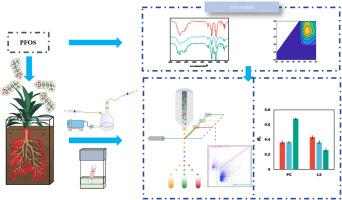当前位置:
X-MOL 学术
›
Environ. Pollut.
›
论文详情
Our official English website, www.x-mol.net, welcomes your
feedback! (Note: you will need to create a separate account there.)
Interaction Between Root Exudates and PFOS Mobility: Effects on Rhizosphere Microbial Health in Wetland Ecosystems
Environmental Pollution ( IF 7.6 ) Pub Date : 2024-11-16 , DOI: 10.1016/j.envpol.2024.125324 Bianhe Lu, Peifang Wang, Yueming Zhu, Jing Hu, Jin Qian, Yuanyuan Huang, Junwei Shen, Sijing Tang, Yin Liu
Environmental Pollution ( IF 7.6 ) Pub Date : 2024-11-16 , DOI: 10.1016/j.envpol.2024.125324 Bianhe Lu, Peifang Wang, Yueming Zhu, Jing Hu, Jin Qian, Yuanyuan Huang, Junwei Shen, Sijing Tang, Yin Liu

|
Perfluorooctanesulfonate (PFOS), a persistent organic pollutant, poses significant ecological risks. This study investigates the effects of PFOS on rhizosphere microbial communities of two wetland plants, Lythrum salicaria (LS) and Phragmites communis (PC). We conducted microcosm experiments to analyze the physiological status of soil microbes under varying PFOS concentrations and examined the role of root exudates in modulating PFOS mobility. Flow cytometry and soil respiration measurements revealed that PFOS exposure increased microbial mortality, with differential impacts observed between LS and PC rhizospheres. LS root exudates intensified microbial stress, whereas PC exudates mitigated PFOS toxicity. Thin-layer chromatography indicated that LS exudates decreased PFOS mobility, leading to higher local concentrations and increased microbial toxicity, while PC exudates enhanced PFOS mobility, reducing its local impact. Fourier-transform infrared spectroscopy and excitation-emission matrix fluorescence spectroscopy of root exudates identified compositional shifts under PFOS stress, highlighting distinct defense strategies in LS and PC. These findings underscore the importance of plant-microbe interactions and root exudate composition in determining microbial resilience to PFOS contamination.
中文翻译:

根系分泌物与 PFOS 迁移性之间的相互作用:对湿地生态系统根际微生物健康的影响
全氟辛烷磺酸盐 (PFOS) 是一种持久性有机污染物,具有重大的生态风险。本研究调查了全氟辛烷磺酸对两种湿地植物——水杨 (LS) 和芦苇 (PC) 的根际微生物群落的影响。我们进行了微观实验,分析了不同 PFOS 浓度下土壤微生物的生理状态,并研究了根系分泌物在调节 PFOS 迁移中的作用。流式细胞术和土壤呼吸测量显示,全氟辛烷磺酸暴露增加了微生物死亡率,在 LS 和 PC 根际之间观察到了不同的影响。LS 根系分泌物加剧了微生物应激,而 PC 渗出物减轻了 PFOS 毒性。薄层色谱表明,LS 渗出物降低了 PFOS 的迁移率,导致局部浓度升高和微生物毒性增加,而 PC 渗出物增强了 PFOS 迁移率,减少了其对局部的影响。根系分泌物的傅里叶变换红外光谱和激发-发射矩阵荧光光谱确定了 PFOS 胁迫下的成分变化,突出了 LS 和 PC 的不同防御策略。这些发现强调了植物与微生物的相互作用和根系分泌物组成在确定微生物对 PFOS 污染的恢复力方面的重要性。
更新日期:2024-11-16
中文翻译:

根系分泌物与 PFOS 迁移性之间的相互作用:对湿地生态系统根际微生物健康的影响
全氟辛烷磺酸盐 (PFOS) 是一种持久性有机污染物,具有重大的生态风险。本研究调查了全氟辛烷磺酸对两种湿地植物——水杨 (LS) 和芦苇 (PC) 的根际微生物群落的影响。我们进行了微观实验,分析了不同 PFOS 浓度下土壤微生物的生理状态,并研究了根系分泌物在调节 PFOS 迁移中的作用。流式细胞术和土壤呼吸测量显示,全氟辛烷磺酸暴露增加了微生物死亡率,在 LS 和 PC 根际之间观察到了不同的影响。LS 根系分泌物加剧了微生物应激,而 PC 渗出物减轻了 PFOS 毒性。薄层色谱表明,LS 渗出物降低了 PFOS 的迁移率,导致局部浓度升高和微生物毒性增加,而 PC 渗出物增强了 PFOS 迁移率,减少了其对局部的影响。根系分泌物的傅里叶变换红外光谱和激发-发射矩阵荧光光谱确定了 PFOS 胁迫下的成分变化,突出了 LS 和 PC 的不同防御策略。这些发现强调了植物与微生物的相互作用和根系分泌物组成在确定微生物对 PFOS 污染的恢复力方面的重要性。


















































 京公网安备 11010802027423号
京公网安备 11010802027423号